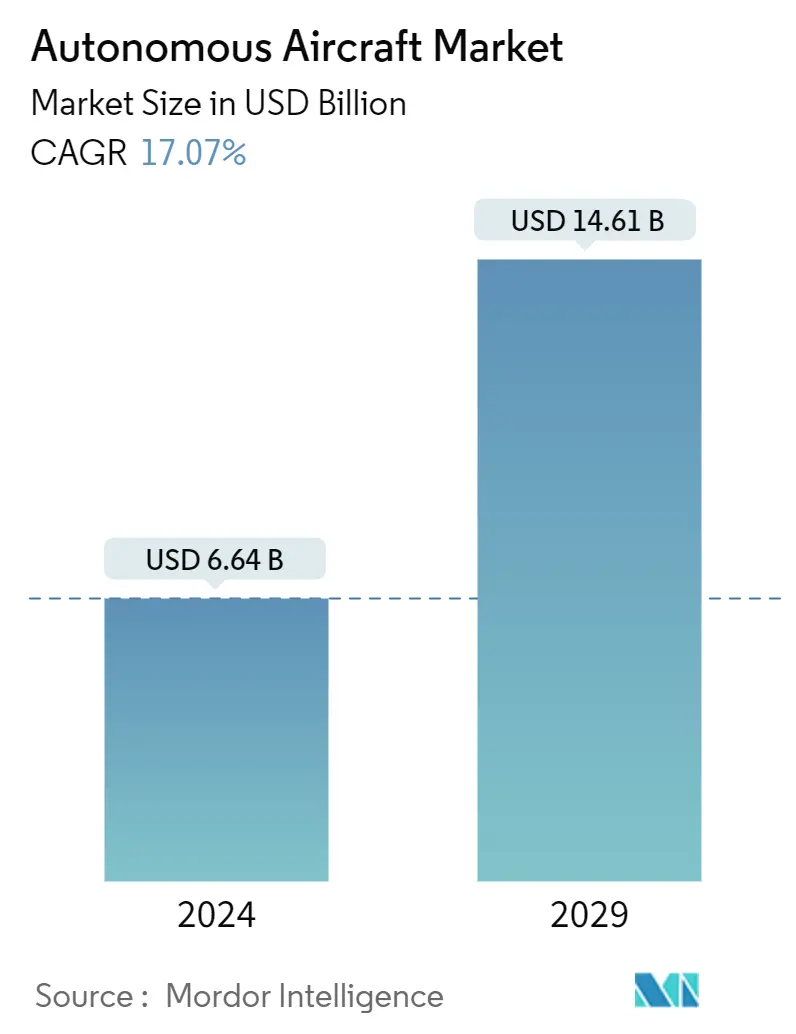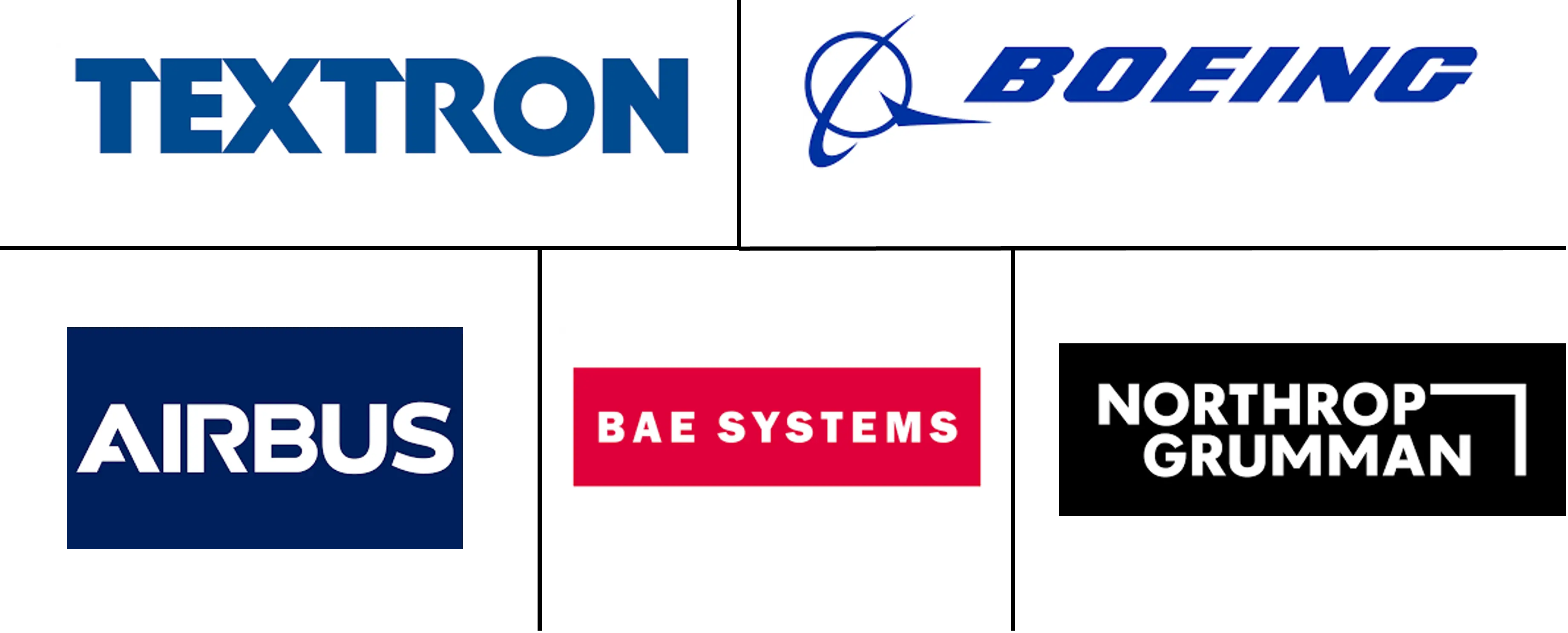Market Size of Autonomous Aircraft Industry

| Study Period | 2019-2029 |
| Market Size (2024) | USD 6.64 Billion |
| Market Size (2029) | USD 14.61 Billion |
| CAGR (2024 - 2029) | 17.07 % |
| Fastest Growing Market | North America |
| Largest Market | North America |
Major Players
*Disclaimer: Major Players sorted in no particular order |
Autonomous Aircraft Market Analysis
The Autonomous Aircraft Market size is estimated at USD 6.64 billion in 2024, and is expected to reach USD 14.61 billion by 2029, growing at a CAGR of 17.07% during the forecast period (2024-2029).
The autonomous aircraft market is going through a transformative phase, driven by the intersection of safety regulations, technological advancements, and collaborative initiatives within the aviation industry. Safety enhancement and cost efficiency emerge as primary drivers, echoing the aviation industry's quest for innovative solutions to improve operational efficiency. There is a constant target for reducing the dependence on traditional pilot-centric models and increasing air safety through automation that surpasses human performance in certain scenarios.
The autonomous aircraft market faces substantial restraint in the form of regulatory challenges and public perception about no-pilot flying. The FAA and other aviation authorities are certifying the safety of autonomous systems, but the public's trust in pilotless flights remains a significant obstacle. Moreover, concerns from pilot unions and the broader public about removing the human element persist, requiring authorities to maintain a delicate balance to integrate autonomous systems in aircraft successfully.
Despite these challenges, technological advancements, especially in machine learning and AI, are propelling the autonomous aircraft industry forward. Companies like Xwing are conducting automated test missions and planning to equip autonomous systems onboard cargo aircraft.
Autonomous Aircraft Industry Segmentation
Autonomous aircraft can be defined as an unmanned aircraft that does not require pilot intervention in the management of the flight.
The autonomous aircraft market is segmented by aircraft type, end-user, application, and geography. By end-user, the market is segmented into commercial and defense. By application, the market is segmented into cargo aircraft and passenger aircraft. The market is segmented by aircraft type into fixed-wing and rotary-wing. The report also covers the market sizes and forecasts for the autonomous aircraft market in major countries across different regions. For each segment, the market sizing and forecasts have been done based on value (USD).
| Aircraft Type | |
| Fixed-wing | |
| Rotary-wing |
| Application | |
| Cargo Aircraft | |
| Passenger Aircraft |
| End-user | |
| Commercial | |
| Defense |
| Geography | ||||||||
| ||||||||
| ||||||||
| ||||||||
| ||||||||
|
Autonomous Aircraft Market Size Summary
The autonomous aircraft market is undergoing a significant transformation, driven by advancements in technology and a focus on enhancing safety and cost efficiency within the aviation industry. This market is characterized by a shift away from traditional pilot-centric models towards increased automation, which aims to improve operational efficiency and air safety. Despite the promising technological developments, the market faces challenges such as regulatory hurdles and public skepticism regarding pilotless flights. These challenges are compounded by concerns from pilot unions and the public about the removal of human oversight in aviation, necessitating a careful approach to the integration of autonomous systems in aircraft.
Technological advancements, particularly in machine learning and artificial intelligence, are propelling the autonomous aircraft industry forward, with companies like Xwing leading the charge in automated test missions. The initial focus is on cargo aircraft, where the absence of human passengers reduces safety concerns, making it a more viable starting point for autonomous technology adoption. The growth of the e-commerce sector is further driving demand for air cargo, potentially increasing the need for autonomous cargo pilots. The market is still in its early stages, with a few key players dominating, particularly in the defense sector. However, ongoing research and development, especially in the military sector, continue to drive market growth, with countries like the US at the forefront of developing advanced autonomous aircraft capable of operating without human intervention.
Autonomous Aircraft Market Size - Table of Contents
-
1. MARKET DYNAMICS
-
1.1 Market Overview
-
1.2 Market Drivers
-
1.3 Market Restraints
-
1.4 Porter's Five Forces Analysis
-
1.4.1 Bargaining Power of Suppliers
-
1.4.2 Bargaining Power of Buyers/Consumers
-
1.4.3 Threat of New Entrants
-
1.4.4 Threat of Substitute Products
-
1.4.5 Intensity of Competitive Rivalry
-
-
-
2. MARKET SEGMENTATION
-
2.1 Aircraft Type
-
2.1.1 Fixed-wing
-
2.1.2 Rotary-wing
-
-
2.2 Application
-
2.2.1 Cargo Aircraft
-
2.2.2 Passenger Aircraft
-
-
2.3 End-user
-
2.3.1 Commercial
-
2.3.2 Defense
-
-
2.4 Geography
-
2.4.1 North America
-
2.4.1.1 United States
-
2.4.1.2 Canada
-
-
2.4.2 Europe
-
2.4.2.1 United Kingdom
-
2.4.2.2 France
-
2.4.2.3 Germany
-
2.4.2.4 Italy
-
2.4.2.5 Russia
-
2.4.2.6 Rest of Europe
-
-
2.4.3 Asia-Pacific
-
2.4.3.1 China
-
2.4.3.2 India
-
2.4.3.3 Japan
-
2.4.3.4 South Korea
-
2.4.3.5 Rest of Asia-Pacific
-
-
2.4.4 Latin America
-
2.4.4.1 Brazil
-
2.4.4.2 Mexico
-
2.4.4.3 Rest of Latin America
-
-
2.4.5 Middle East and Africa
-
2.4.5.1 Saudi Arabia
-
2.4.5.2 United Arab Emirates
-
2.4.5.3 Turkey
-
2.4.5.4 South Africa
-
2.4.5.5 Rest of Middle East and Africa
-
-
-
Autonomous Aircraft Market Size FAQs
How big is the Autonomous Aircraft Market?
The Autonomous Aircraft Market size is expected to reach USD 6.64 billion in 2024 and grow at a CAGR of 17.07% to reach USD 14.61 billion by 2029.
What is the current Autonomous Aircraft Market size?
In 2024, the Autonomous Aircraft Market size is expected to reach USD 6.64 billion.

